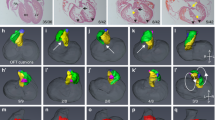Abstract
Previous studies revealed a significant association between genes at or near the H-2 complex and fetal loss. Reasoning that the maternal serum might contain one or more unknown factors that are harmful to early embryonic or fetal development, or both, we performed an embryotoxicity screen using chick embryos and serum from nonpregnant C57BL/10Sn(H-2 b) and B10.A/SnSg (H-2 a) congenic mice. Serum from the strain with the higher frequency of fetal loss (C57BL/10 Sn) yielded a significantly greater frequency of chick abnormality, specifically neural tube malformation and death, than the serum from the strain with the lower frequency of fetal loss (B10.A/SnSg). Further, the C57BL/10 Sn serum demonstrated a highly significant dose-response. These results suggest that analogous studies may be profitable with women who have a history of chronic fetal wastage and/or offspring with neural tube defects.
Similar content being viewed by others
References
Carter, C. O.: Genetics of common single malformations. Br. Med. Bull. 32: 21–26, 1976
Fellous, M., Hors, J., Boue, J., Dausset, J., and Jacob, F.: Are there human analogs of the mouse T locus in central nervous system malformations? Birth Defects 15 (3): 93–104, 1979
Hamburger, V. and Hamilton, H. W.: A series of normal stages in the development of the chick embryo. J. Morph. 88: 49–92, 1951
Heap, R. B., Flint, A. P., and Gadsby, J.E.: Role of embryonic signals in the establishment of pregnancy. Br. Med. Bull. 35: 129–135, 1979
Melnick, M.: Current concepts of the etiology of central nervous system malformations. Birth Defects 15(3): 19–41, 1979
Melnick, M., Jaskoll, T., and Slavkin, H. C.: The association of H-2 haplotype with implantation, survival and growth of murine embryos. Immunogenetics 14: 303–308, 1981
Myrianthopoulos, N. C.: Our load of central nervous system malformations. Birth Defects 15(3): 1–18, 1979
Nishimura, H.: Incidence of malformations in abortions. In F. C. Fraser and V. A. McKusick (eds.): Congenital Malformations: Proceedings of the Third International Conference, pp. 275–283, Excerpta Medica, Amsterdam, 1970
Roberts, C. J. and Lloyd, S.: Area differences in spontaneous abortion rates in South Wales and their relation to neural tube defect incidence. Br. Med. J. 4: 20–22, 1973
Roberts, C. J. and Lowe, C. R.: Where have all the conceptions gone? Lancet 1: 498–499, 1975
Ruderman, R. J., Mendell, N. R., and Ruderman, J. G.: Evidence for linkage between HLA and spinal malformation in man. In J. W. Littlefields (ed.): Abstracts of Papers. Fifth International Conference on Birth Defects, p. 64, Excerpta Medica, Amsterdam, 1977
Sokal, R. R. and Rohlf, F. F.: Biometry. W. H. Freeman and Company, San Francisco, 1969
Author information
Authors and Affiliations
Rights and permissions
About this article
Cite this article
Melnick, M., Marazita, M. H-2 haplotype and the embryotoxicity of serum from nonpregnant congenic mice. Immunogenetics 18, 131–135 (1983). https://doi.org/10.1007/BF00368541
Received:
Issue Date:
DOI: https://doi.org/10.1007/BF00368541




